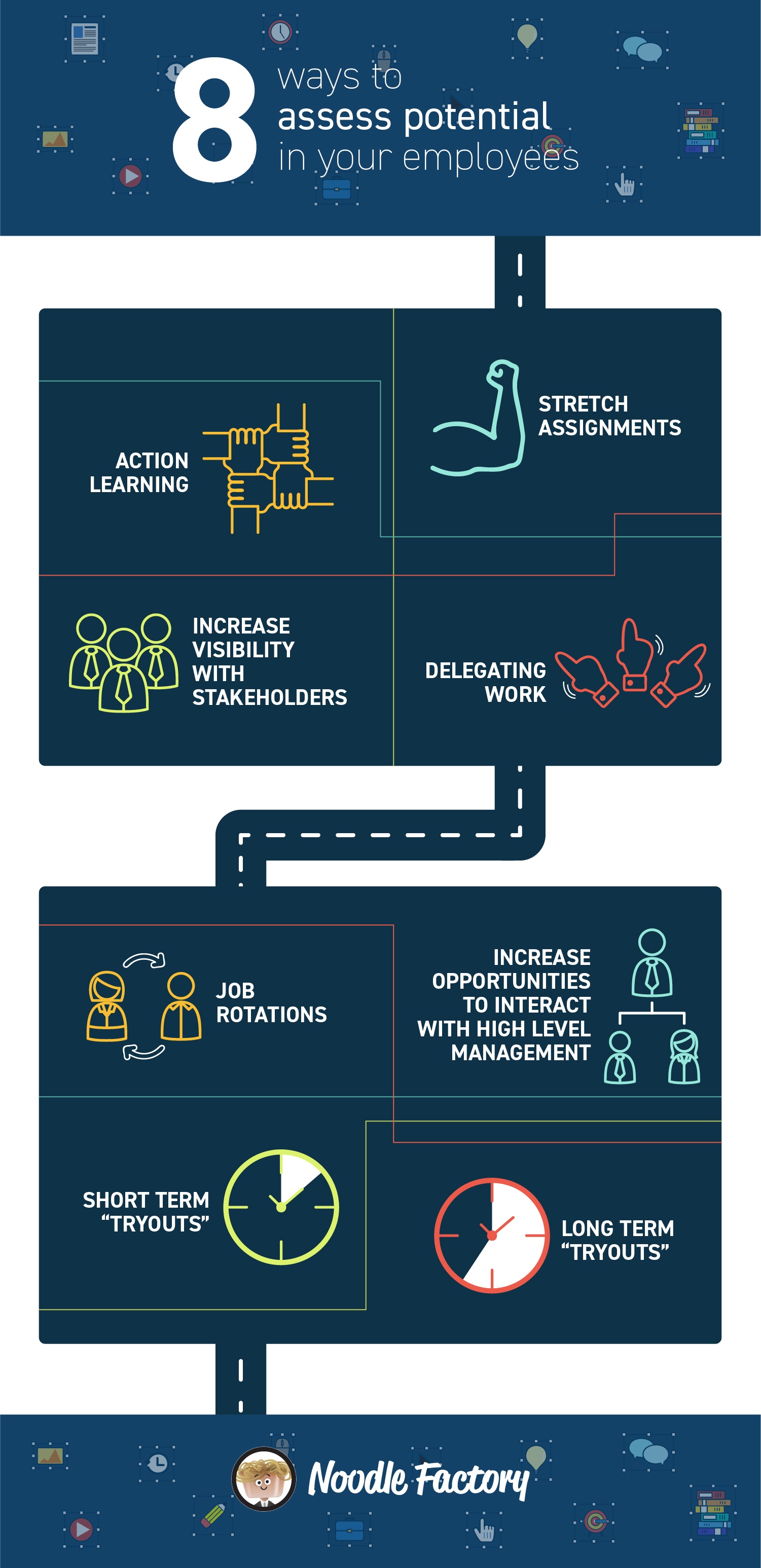
8 Ways to Assess Potential in Your Employees
Oct 25, 2017How do you identify employees with potential? How do you know if someone is capable of taking on more responsibility or move on to leadership positions? Some companies may have formal programmes to select certain employees and observing their progress over a period of time while other companies wait till a crisis - such as a serious illness or sudden loss of key personnel to find the right people to fill the gaps. Here are some possibilities to consider to help you assess potential in your employees.
Approach 1: Action Learning
Action learning is a process where individuals come together as a team to solve real problems. It provides developmental experiences for individuals from various job functions to work on a real business issue facing the organisation. While traditional classroom training does not penalise the learners for failure, action learning has real stakes for everyone involved in the project. This experience may increase visibility of the team members to important decision makers such as the C-level executives. If the team is able to overcome the problem or crisis facing the company, a promotion or pay raise is imminent. On the other hand, all members have to share the blame if they are not able to resolve the business problem.
Approach 2: Stretch assignments
Stretch assignments are tasks that employees perform within their role, but beyond their job description. While most organisations may have earmarked certain individuals to be next-in-line for leadership positions, setting stretch assignments are opportunities for you to decide on their suitability. For instance, when you assign a flailing project or a difficult situation to employees, the process of working on those projects will give you a glimpse of whether they are resilient, decisive, flexible-qualities of a leader. However, managers will have to be careful with this strategy and avoid promises of pay raises or promotion prospects to the employees.
Approach 3: Increase visibility with stakeholders
Customers, suppliers and distributors are a part of the stakeholder group within your organisation. They work together with your employees and the feedback they provide will give you valuable insights of the promotion potential of your employees. This group of stakeholders may hold different expectations of your employees as compared to the key personnel of your organisation. Therefore, they could offer you new and alternative perspectives of the employees they interact with.
Approach 4: Delegating work
Another method of assessing employees’ potential is via delegating work to them. Delegating work allows the best use of your time and skills and also develops potential in your employees. Many managers make the mistake of thinking that they need not be involved once they have delegated the task. Delegation is a learning experience for your employees. Give constructive feedback at regular intervals. Tell them what they are doing well and be specific about what they need to improve on. Managers tap on the strengths of their employees and opens up career growth opportunities through the process of delegating work.
Approach 5: Job rotations
Job rotations allow employees to be exposed to various job functions within the organisation. It is a good strategy to test promising individuals and to enhance their job competencies. When you assign individuals to job rotations, you are also increasing their visibility to others to be observed, assessed and developed by others. However, managers need to give some thought to what kind of skills or knowledge they would like the employees to pick up so that the employees are clear on what they should achieve by the end of the job rotation. Goals set should be measurable and achievable. Managers will then approach the supervisors or department heads where the employee is executing the job rotation to give you formal and informal feedback on how well they are performing.
Approach 6: Increase opportunities to interact with high level management
By exposing employees to senior management, it will naturally prompt curiosity and invite attention to focus on them. Such opportunities may come in the form of a formal setting, such as offering a role in delivering a report to the management team during important meetings or informally bringing them for dinners or golf with key personnel. Senior management could also offer their feedback of these potential candidates from their interactions and observations of them. Very often, there is hesitation to promote people who are unknown to the company’s top management. Therefore, giving these employees some “air time” broadens their relationships and hone their skills in communicating well with higher-ups.
Approach 7: Short term “tryouts”
What happens when head of departments or supervisors are on “sick leave” for a few days? It is possible to assign one of the employees reporting to the head of department to cover his or her duties in their absence. When the individual has completed this short stint, a formal assessment may be conducted to gauge how well the individual performed the role. This short term “tryout” should not exceed more than 2 weeks as it is not meant to be a permanent position and it may potentially disrupt the usual job duties for both the absentee and the employee.
Approach 8: Long term “tryouts”
Most of us would have come across terms like “Acting Manager” who are individuals appointed to cover the incumbent’s job duties for a duration of time, possibly due to maternity leave or illness. The lower level job activities are absorbed by others so that the individual who is tasked to be “acting manager” can tackle new learning possibilities and develop competencies to manage the heavier responsibilities. Management can then assess if the individual can perform to expectations and if they do succeed, they may be rewarded with a job promotion or performance bonus.



